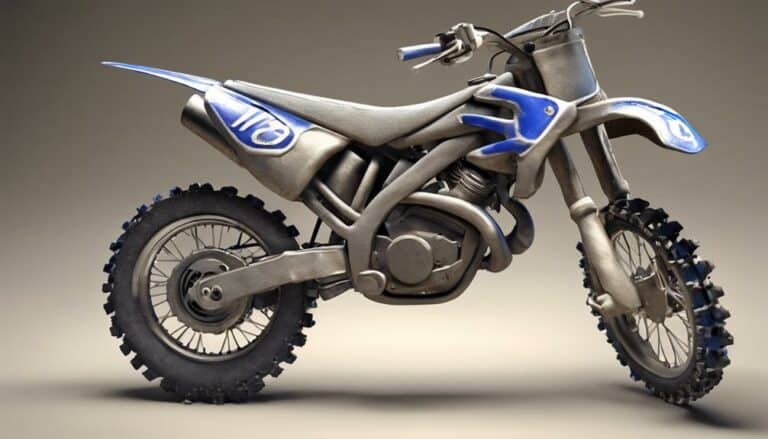When it comes to mastering the art of dirt bike control, think of your body as the conductor of a symphony, orchestrating every move with precision and finesse.
Proper body positioning is not just about looking the part; it's about becoming one with your bike, seamlessly blending into every turn, jump, and obstacle that comes your way.
But what exactly are the key elements that will elevate your riding skills to the next level? Let's uncover the secrets behind achieving peak control and balance on your dirt bike.
Key Takeaways
- Achieve ultimate balance and control by mastering proper body positioning techniques.
- Enhance stability and traction on the bike through correct foot and hand placement.
- Anticipate the path ahead to maintain control and maximize the riding experience.
- Improve turns and control by leaning the bike while keeping the body upright and using countersteering.
Importance of Proper Body Positioning
Mastering proper body positioning on a dirt bike is paramount for achieving ultimate balance, control, and performance while riding. The way you position your body influences important aspects such as balance, control, traction, and stability. By positioning your body correctly, you enhance your overall stability on the bike, making it easier to navigate through challenging terrains. This best body positioning not only improves your balance but also maximizes your control over the bike, ensuring a smoother and more responsive riding experience.
When you maintain the right body positioning, you distribute your weight effectively, enhancing traction with the ground. This increased traction boosts your control over the bike, allowing you to handle corners, bumps, and obstacles with greater ease. Additionally, proper body positioning reduces the strain on your muscles, minimizing fatigue and improving your overall endurance on longer rides.
Ultimately, mastering body positioning techniques is key to revealing the full potential of your dirt biking adventures, making them safer, more enjoyable, and ultimately more successful.
Foundational Riding Stance
To maintain the best balance and control on a dirt bike, adopting the foundational riding stance is essential. This stance involves standing on the footpegs with slightly bent knees, which serves to absorb shocks from the terrain and provides stability.
Ensuring even weight distribution on both feet is vital as it enhances control and maneuverability on the bike. By keeping a relaxed grip on the handlebars and sitting closer to the gas tank, you can greatly improve overall control and handling of the bike.
Proper foot placement on the footpegs plays a pivotal role in maintaining balance and control while riding. Practicing balancing on the footpegs, both when stationary and in motion, is a valuable exercise to develop better stability and control skills.
Embracing this foundational riding stance won't only enhance your riding experience but also boost your confidence in handling the bike with ease and precision.
Mastering Foot and Hand Placement
Placing your feet and hands correctly on a dirt bike is fundamental for achieving maximum balance and control while riding. To master foot and hand placement, consider the following key elements:
- Position the balls of your feet on the footpegs: By placing the balls of your feet on the footpegs, you enable quick shifts in weight distribution, enhancing your control over the bike.
- Maintain even weight distribution: Keeping your weight evenly distributed on both feet helps you stay stable and improves maneuverability, allowing you to navigate different terrains with ease.
- Optimize hand position for control: Ensuring your hands are placed correctly on the handlebars with a relaxed grip enhances responsiveness and precision in steering, granting you better control over the bike's movements.
Anticipating the Path Ahead
Proper anticipation of the path ahead is key to maintaining control and maximizing your riding experience on a dirt bike. Anticipating terrain changes allows you to proactively adjust your body positioning, ensuring smoother control and enhanced stability. By visualizing the ideal line and anticipating upcoming obstacles, you can prepare yourself for the necessary adjustments in body positioning to tackle the challenges ahead with confidence.
Looking ahead not only promotes safety but also boosts your speed and overall enjoyment while riding. Your ability to anticipate the path enables you to react promptly to terrain variations, optimizing your control over the bike. Remember, adjusting your body position based on the upcoming terrain features is essential for maintaining stability and control throughout your ride.
Essentially, mastering the skill of anticipating the path ahead empowers you to ride with greater precision, ensuring you can navigate through obstacles with ease while prioritizing your safety and enhancing your dirt bike experience.
Techniques for Turns and Control
Master the art of leaning your bike into turns while keeping your body upright for maximum control and stability. To enhance your dirt bike control during cornering, follow these techniques:
- Utilize your knee grip: Securely grip the bike with your knees to maintain stability and control while leaning into turns.
- Shift your weight to the outside footpeg: By transferring your weight to the outside footpeg, you can stabilize the bike and improve your cornering abilities.
- Practice countersteering: Initiate turns effectively by pushing on the inside handlebar, allowing you to navigate corners with precision and ease.
Conclusion
To sum up, mastering proper body positioning on a dirt bike is like finding your groove on the dance floor – smooth, controlled, and in perfect harmony with the music.
By honing your stance, foot and hand placement, and anticipation skills, you can glide through turns and obstacles with ease.
So, saddle up, embrace the ride, and let your body flow with the rhythm of the trail.
Happy riding!

